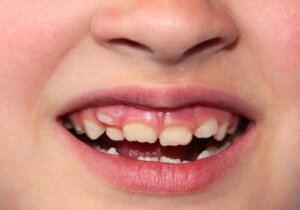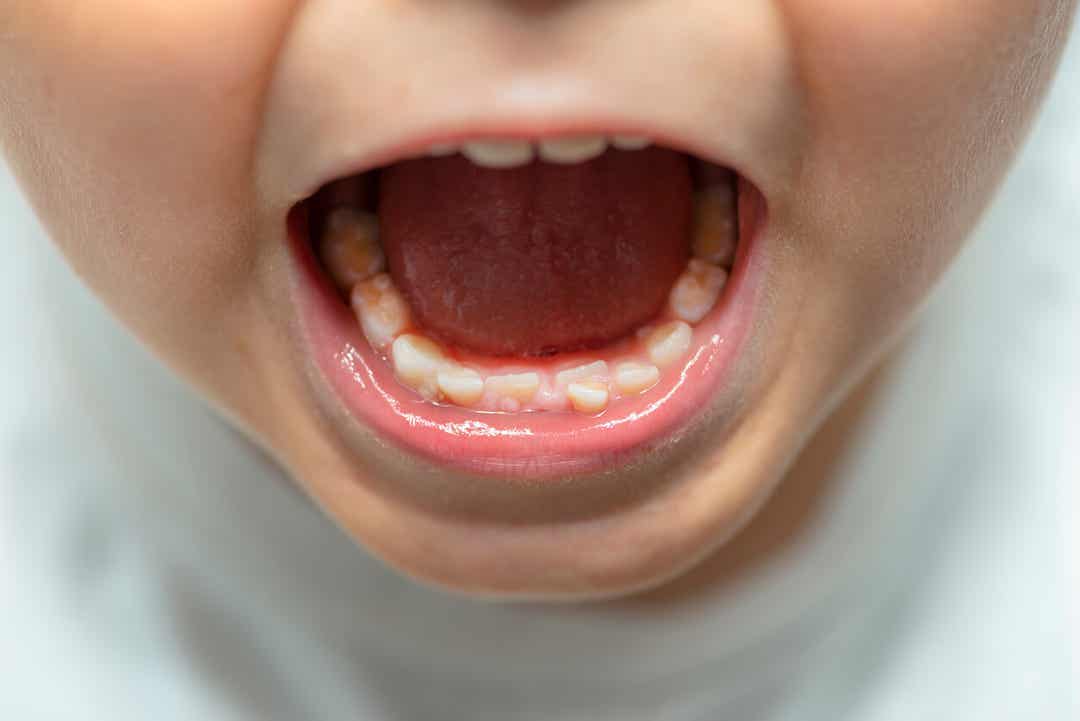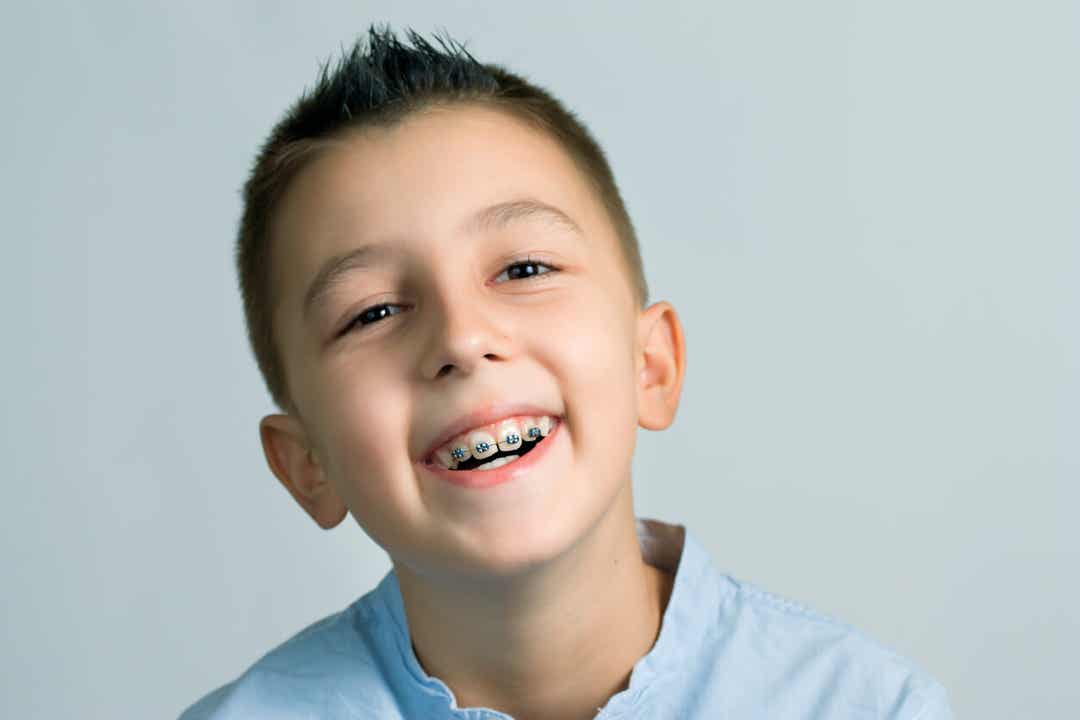Misplaced Teeth in Children: What to Do?

Crooked or misplaced teeth in children are a frequent concern of parents. Having a misaligned smile generates social problems for the child, who may be teased and feel ashamed of the appearance of their mouth, causing low self-esteem.
But it doesn’t only have these aesthetic and social consequences. The presence of poorly positioned teeth can cause alterations in the mouth that we’ll explain in greater detail below. In addition, we’ll guide you on the action to take if your child suffers from this problem.
Most common problems of misplaced in children
As we’ve already mentioned, one of the consequences of poorly positioned teeth in children is the appearance they give to smiles. In addition, a bite that’s misaligned can cause other alterations.
Children may have problems chewing, eating, and speaking, or suffer from headaches or earaches. In addition, crooked and crowded teeth retain food debris and make oral hygiene difficult, favoring the appearance of various diseases in the mouth.
The following are the main consequences of misplaced teeth in children.
Aesthetic problems

As we’ve already mentioned, misplaced teeth in children alter the appearance of their smiles. People tend to consider harmonious and aligned teeth as beautiful, and having crooked and crowded teeth doesn’t meet this standard of beauty.
This damages the self-esteem of children, who may feel embarrassed about the appearance of their mouth. In addition, they may suffer from teasing and laughter from their peers, which increases the feelings of insecurity about their self-image. Hiding their smile is a fairly common behavior in children suffering from this problem.
Misplaced teeth and poor oral hygiene
Misplaced teeth in children can interfere with oral hygiene. Because they’re not aligned correctly, food accumulates in certain areas that are inaccessible to brushing and flossing.
Bacterial plaque increases in these areas and can become calcified, giving rise to tartar deposits. This large proliferation of bacteria gives rise to other oral problems such as bad breath, cavities, and gingivitis.
Cavities
As plaque accumulates in areas where neither brushing nor flossing can remove it, the risk of cavities increases. The accumulated bacteria metabolize dietary carbohydrates and produces an acid capable of demineralizing the teeth.
This repeated and sustained activity destroys the hard tissues of the teeth. First, it appears as a white spot that, if continued, will darken. Then, holes appear, starting in the enamel and advancing towards the dentin, and may even affect the pulp.
Gingivitis
Gingivitis in children also comes from the accumulation of bacterial plaque in areas where it’s difficult to eliminate. These microorganisms produce an inflammatory response of the gingival tissue, which swells, hurts, turns red, and bleeds easily.
If left untreated, it can evolve into periodontitis or pyorrhea. Although this isn’t as common in children, it’s a possibility. Here, the infection is much deeper, affecting the tissues that support the tooth, such as the periodontal ligament and bone.
Tooth wear
The bite functions properly when the upper and lower teeth interact harmoniously, similar to a perfect gear. When teeth are crooked and out of place, they generate collisions and abrupt contacts that end up injuring the teeth involved.
It’s common to observe the progressive wear of some areas of the dental surface as a consequence of misplaced teeth. Since they aren’t aligned, the bite produces atypical contacts that rub and wear down the hard tissues of the teeth.
Solutions to misplaced teeth in children
To correct misaligned teeth in children, orthodontic treatment is necessary. There are several alternatives of appliances to be used that’ll depend on the particularity of each clinical case, the age of the patient, their needs, and possibilities.
Below, we’ll go into detail regarding the most common orthodontic treatments for solving the problems of misplaced teeth in children.
Orthodontics with braces

Braces are a method of fixed orthodontics that the dentist places on the teeth and the patient can’t remove. They consist of brackets, elements that adhere to the surface of the teeth, and the metal arch that goes through them. Sometimes it’s necessary to add other attachments to this system.
The structures of the appliance produce pressure that’s capable of mobilizing the teeth. They’re capable of individually moving each and every tooth in any direction.
They’re used during adolescence after the permanent teeth have already grown in, but taking advantage of the fact that the bone’s still growing. They come in different materials to meet the aesthetic needs and economic possibilities of the patient.
Therefore, there are sapphire, ceramic, and lingual brackets for those who prefer for their braces to be unnoticeable. And there are also metal brackets, which are more economical. What’s more, you can combine them with different colored elastic bands to make the process more fun.
Invisible orthodontics for misplaced teeth
Invisible orthodontics is characterized by being removable, that is, the patient can apply and remove the appliance. It’s an esthetic and comfortable method that’s suitable for children, obtaining the same results as with fixed orthodontics.
It consists of a group of transparent plastic trays that are made specifically for each patient’s mouth. It’s important to replace them from time to time so that they exert the necessary pressure to mobilize the teeth.
The patient can remove them in order to eat and brush their teeth as usual. However, the success of the therapy depends on using them for most of the day, at least 22 hours a day.
Misplaced teeth: when’s the best time to start orthodontics?
Frequent dental check-ups allow for any problems to be detected in time. If a pediatric dentist discovers a problem in the bite, they’ll begin to solve it or make the corresponding referral to an orthodontist to prevent the situation from progressing.
The earlier you begin to treat these disorders in the mouth, the easier and more comfortable the therapy is and the better the results. Going to the orthodontist from the age of six and continuing with periodic check-ups allows the professional to monitor the emergence of the teeth. Therefore, if there’s any alteration, they’ll detect it and treat it early.
It’s best to perform these corrections as soon as possible in young patients where the bone is still soft and growing. In adults, treatments are more time-consuming, costly, and difficult.
Frequent dental visits are the key
Misplaced teeth in children can cause many problems in the mouth, not only affecting the child’s appearance. Regular visits to the dentist allow these situations to be detected and resolved early. This not only improves the child’s quality of life but also prevents longer and more expensive treatments in the future.
Maintaining proper dental hygiene in the mouth is also vital. By following our advice, you’ll help your little ones to smile with peace of mind.
Crooked or misplaced teeth in children are a frequent concern of parents. Having a misaligned smile generates social problems for the child, who may be teased and feel ashamed of the appearance of their mouth, causing low self-esteem.
But it doesn’t only have these aesthetic and social consequences. The presence of poorly positioned teeth can cause alterations in the mouth that we’ll explain in greater detail below. In addition, we’ll guide you on the action to take if your child suffers from this problem.
Most common problems of misplaced in children
As we’ve already mentioned, one of the consequences of poorly positioned teeth in children is the appearance they give to smiles. In addition, a bite that’s misaligned can cause other alterations.
Children may have problems chewing, eating, and speaking, or suffer from headaches or earaches. In addition, crooked and crowded teeth retain food debris and make oral hygiene difficult, favoring the appearance of various diseases in the mouth.
The following are the main consequences of misplaced teeth in children.
Aesthetic problems

As we’ve already mentioned, misplaced teeth in children alter the appearance of their smiles. People tend to consider harmonious and aligned teeth as beautiful, and having crooked and crowded teeth doesn’t meet this standard of beauty.
This damages the self-esteem of children, who may feel embarrassed about the appearance of their mouth. In addition, they may suffer from teasing and laughter from their peers, which increases the feelings of insecurity about their self-image. Hiding their smile is a fairly common behavior in children suffering from this problem.
Misplaced teeth and poor oral hygiene
Misplaced teeth in children can interfere with oral hygiene. Because they’re not aligned correctly, food accumulates in certain areas that are inaccessible to brushing and flossing.
Bacterial plaque increases in these areas and can become calcified, giving rise to tartar deposits. This large proliferation of bacteria gives rise to other oral problems such as bad breath, cavities, and gingivitis.
Cavities
As plaque accumulates in areas where neither brushing nor flossing can remove it, the risk of cavities increases. The accumulated bacteria metabolize dietary carbohydrates and produces an acid capable of demineralizing the teeth.
This repeated and sustained activity destroys the hard tissues of the teeth. First, it appears as a white spot that, if continued, will darken. Then, holes appear, starting in the enamel and advancing towards the dentin, and may even affect the pulp.
Gingivitis
Gingivitis in children also comes from the accumulation of bacterial plaque in areas where it’s difficult to eliminate. These microorganisms produce an inflammatory response of the gingival tissue, which swells, hurts, turns red, and bleeds easily.
If left untreated, it can evolve into periodontitis or pyorrhea. Although this isn’t as common in children, it’s a possibility. Here, the infection is much deeper, affecting the tissues that support the tooth, such as the periodontal ligament and bone.
Tooth wear
The bite functions properly when the upper and lower teeth interact harmoniously, similar to a perfect gear. When teeth are crooked and out of place, they generate collisions and abrupt contacts that end up injuring the teeth involved.
It’s common to observe the progressive wear of some areas of the dental surface as a consequence of misplaced teeth. Since they aren’t aligned, the bite produces atypical contacts that rub and wear down the hard tissues of the teeth.
Solutions to misplaced teeth in children
To correct misaligned teeth in children, orthodontic treatment is necessary. There are several alternatives of appliances to be used that’ll depend on the particularity of each clinical case, the age of the patient, their needs, and possibilities.
Below, we’ll go into detail regarding the most common orthodontic treatments for solving the problems of misplaced teeth in children.
Orthodontics with braces

Braces are a method of fixed orthodontics that the dentist places on the teeth and the patient can’t remove. They consist of brackets, elements that adhere to the surface of the teeth, and the metal arch that goes through them. Sometimes it’s necessary to add other attachments to this system.
The structures of the appliance produce pressure that’s capable of mobilizing the teeth. They’re capable of individually moving each and every tooth in any direction.
They’re used during adolescence after the permanent teeth have already grown in, but taking advantage of the fact that the bone’s still growing. They come in different materials to meet the aesthetic needs and economic possibilities of the patient.
Therefore, there are sapphire, ceramic, and lingual brackets for those who prefer for their braces to be unnoticeable. And there are also metal brackets, which are more economical. What’s more, you can combine them with different colored elastic bands to make the process more fun.
Invisible orthodontics for misplaced teeth
Invisible orthodontics is characterized by being removable, that is, the patient can apply and remove the appliance. It’s an esthetic and comfortable method that’s suitable for children, obtaining the same results as with fixed orthodontics.
It consists of a group of transparent plastic trays that are made specifically for each patient’s mouth. It’s important to replace them from time to time so that they exert the necessary pressure to mobilize the teeth.
The patient can remove them in order to eat and brush their teeth as usual. However, the success of the therapy depends on using them for most of the day, at least 22 hours a day.
Misplaced teeth: when’s the best time to start orthodontics?
Frequent dental check-ups allow for any problems to be detected in time. If a pediatric dentist discovers a problem in the bite, they’ll begin to solve it or make the corresponding referral to an orthodontist to prevent the situation from progressing.
The earlier you begin to treat these disorders in the mouth, the easier and more comfortable the therapy is and the better the results. Going to the orthodontist from the age of six and continuing with periodic check-ups allows the professional to monitor the emergence of the teeth. Therefore, if there’s any alteration, they’ll detect it and treat it early.
It’s best to perform these corrections as soon as possible in young patients where the bone is still soft and growing. In adults, treatments are more time-consuming, costly, and difficult.
Frequent dental visits are the key
Misplaced teeth in children can cause many problems in the mouth, not only affecting the child’s appearance. Regular visits to the dentist allow these situations to be detected and resolved early. This not only improves the child’s quality of life but also prevents longer and more expensive treatments in the future.
Maintaining proper dental hygiene in the mouth is also vital. By following our advice, you’ll help your little ones to smile with peace of mind.
All cited sources were thoroughly reviewed by our team to ensure their quality, reliability, currency, and validity. The bibliography of this article was considered reliable and of academic or scientific accuracy.
- Ayala-Galdámez, Tania Lissette, et al. “Prevalencia de maloclusión y necesidad de tratamiento ortodóntico en niños con dentición mixta en cuatro centros escolares salvadoreños utilizando el índice de estética dental durante el año 2015.” Revista Científica Multidisciplinaria de la Universidad de El Salvador-Revista Minerva 1.2 (2018): 15-23. https://minerva.sic.ues.edu.sv/index.php/Minerva/article/view/9
- Velo, Cristina Patricia Estrada. “Comparación entre Invisalign® y el tratamiento de brackets tradicional desde el punto de vista de la higiene bucodental. Evidencia científica.” https://dentaltranslation.com/wp-content/uploads/2019/02/Proyecto-fin-grado-Invisalign-brackets.pdf
- Cartes, Paulina Jovanna Gacitúa, et al. “Principales beneficios de un tratamiento de ortodoncia en niños.” RECIAMUC 4.1 (2020): 333-345. https://www.reciamuc.com/index.php/RECIAMUC/article/view/457
- ORTIZ OBANDO, MARIA CAMILA. DIAGNOSTICO DE SALUD ORAL Y MALPOSICION DENTARIA EN NIÑOS DE 7 A 12 AÑOS DE LA INSTITUCIÓN EDUCATIVA PEDRO LEON TORRES DEL MUNICIPIO DE YACUANQUER 2018. Diss. AUNAR, 2018. http://repositorio.aunar.edu.co:8080/xmlui/handle/20.500.12276/810
- Silva Sampe, Victor Fernando. “PREVALENCIADE MALPOSICIONES DENTARIAS EN PACIENTES DE 18 A 24 AÑOS QUE ACUDEN AL HOSPITAL DE TINGO MARÍA HUÁNUCO 2017.” (2019). http://repositorio.udh.edu.pe/handle/123456789/1865
- Sanca Chavez, Ambar Yosselyn. “La Relación De La Malposición Dentaria Anterior con el Autoestima En Adolescentes de 13 a 17 Años de Edad de la Institución Educativa Privada Sagrado Corazón de Jesús-Juliaca, 2019.” (2021). http://www.repositorio.uancv.edu.pe/handle/UANCV/5199
- Jimenez-Romero, Magaly. “HABLEMOS DE DIENTES TORCIDOS:¿ CÓMO SABER CUÁNDO ACUDIR AL ORTODONCISTA?.” Odontología Activa Revista Científica 3.2 (2018): 37-40. https://oactiva.ucacue.edu.ec/index.php/oactiva/article/view/222
- García-Soliz, Valeria. “PREVALENCIA DE APIÑAMIENTO DENTARIO ANTERIOR Y SU RELACIÓN CON LA GINGIVITIS, EN ADOLESCENTES DE 12 A 15 AÑOS DE LA UNIDAD EDUCATIVA TRES DE NOVIEMBRE, PARROQUIA BELLAVISTA, CUENCA-2015.” Odontología Activa Revista Científica 3.2 (2018): 1-6. https://oactiva.ucacue.edu.ec/index.php/oactiva/article/view/216
This text is provided for informational purposes only and does not replace consultation with a professional. If in doubt, consult your specialist.








